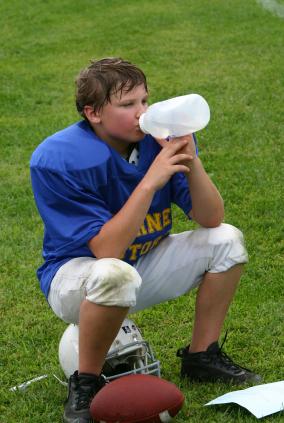 Healthy and successful sports participation requires that athletes hydrate before, and re-hydrate during and after, sports.
Healthy and successful sports participation requires that athletes hydrate before, and re-hydrate during and after, sports.
Dehydration
- Rapid weight loss represents a loss of body water. This can easily occur during the course of a youth sports practice or game. If a child losses weight within one practice or game, it is water that they lost, not fat.
- A loss of just 1-2% of body weight (1.5 to 3 pounds for a 150 pound athlete) can negatively impact performance.
- A loss of 3% or more of body weight can increase the risk for exertional heat related illness. Athletes should therefore be weighed before and after warm weather practice sessions and contests to assess fluid losses.
- Athletes with high body fat percentages can become dehydrated faster than athletes with lower body fat percentages while working out under the same environmental conditions.
- All athletes have different sweating rates and some lose much more salt through their sweat than others. Additionally, some lose more water than others leading to increased levels of dehydration. As children mature into teenagers and young adults sweat rates increase and more salt is conserved.
- Clothing, such as dark, bulky, or rubber protective equipment can drastically increase the chance of dehydration and heat illness.
- Poor acclimatization/fitness levels, medications and fevers can all greatly contribute to an athlete’s dehydration problems.
Environmental conditions and dehydration
- Environmental temperatures and humidity both contribute to dehydration and heat illness. Wet bulb temperature measurements should be taken 10-15 minutes before practices or contests. The results should be used with a heat index or with the Heat Index Calculator at the Oregon School Activities Association’s web site to determine if practices or contests should be started, modified, or stopped.
- Even dry climates can have high humidity if sprinkler systems are scheduled to run before early morning practices start. This collection of water does not evaporate until environmental temperatures increase and dew points lower.
What to drink during sports
For most exercising athletes, the ideal fluid for pre-hydration and re-hydration is water. Water is quickly absorbed, well-tolerated, an excellent thirst quencher, and cost effective.
The use of a sports drink with appropriate carbohydrates (CHO) and sodium as described below may prove beneficial in some general situations and for some individuals.
Traditional sports drinks containing appropriate concentrations of CHO (6-8%) and sodium may provide additional benefit in the following general situations:
- Prolonged continuous activity of greater than 45 minutes
- Extremely intense activity with risk of heat illness
- Extremely hot and humid conditions
- Traditional sports drinks with appropriate CHO and sodium may provide additional benefit for the following individual conditions:
- Poor hydration prior to participation
- Increased sweat rate
- Poor caloric intake prior to participation
- Poor acclimatization to heat and humidity
- A 6-8% addition of CHO to water is the maximum that should be utilized. Any greater concentration will produce slow emptying from the stomach and a bloated feeling.
- The other ingredient that may be helpful is a low concentration ( 0.3 - 0.7 g/L) of sodium which may help with cramping.
- All fluids should be served cold to optimize gastric emptying.








